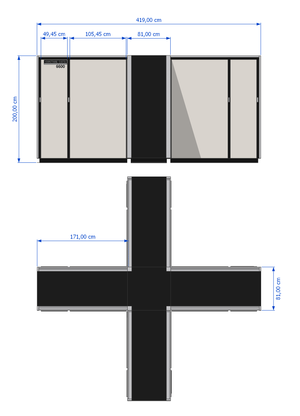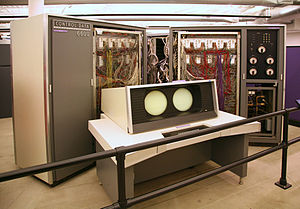| CDC 6600 | |
|---|---|
 3D rendering with a figure as scale | |
| Design | |
| Manufacturer | Control Data Corporation |
| Designer | Seymour Cray |
| Release date | September 1964[1] |
| Units sold | 100+ |
| Price | US$2,370,000[2] (equivalent to $23,280,000 in 2023) |
| Casing | |
| Dimensions | Height : 2,000 mm (79 in) Cabinet width: 810 mm (32 in)[3] Cabinet length : 1,710 mm (67 in)[3] Width overall : 4,190 mm (165 in)[3] |
| Weight | about 12,000 lb (6.0 short tons; 5.4 t)[4] |
| Power | 30 kW @ 208 V 400 Hz[5][2] |
| System | |
| Operating system | SCOPE, KRONOS[6] |
| CPU | 60-bit processor @ 10 MHz[7] |
| Memory | Up to 982 kilobytes (131000 x 60 bits)[1] |
| MIPS | 2 MIPS[7] |
| Predecessor | CDC 1604 |
| Successor | CDC 7600 |



The CDC 6600 was the flagship of the 6000 series of mainframe computer systems manufactured by Control Data Corporation.[8][9] Generally considered to be the first successful supercomputer, it outperformed the industry's prior recordholder, the IBM 7030 Stretch, by a factor of three.[10][11] With performance of up to three megaFLOPS,[12][13] the CDC 6600 was the world's fastest computer from 1964 to 1969, when it relinquished that status to its successor, the CDC 7600.[14]
The first CDC 6600s were delivered in 1965 to Livermore and Los Alamos.[15] They quickly became a must-have system in high-end scientific and mathematical computing, with systems being delivered to Courant Institute of Mathematical Sciences, CERN,[16][17] the Lawrence Radiation Laboratory,[18] and many others. At least 100 were delivered in total.[19]
A CDC 6600 is on display at the Computer History Museum in Mountain View, California. The only running CDC 6000 series machine has been restored by Living Computers: Museum + Labs.
- ^ a b Adams Survey 1968
- ^ a b The Computer Directory And Buyer's Guide 1967
- ^ a b c 6000 Series Site Prep, Sep 65
- ^ "Control Data 6600: The Supercomputer Arrives". Dr. Dobb's. Archived from the original on 2017-06-05. Retrieved 2018-10-06.
- ^ CDC 6400 Central Processor Training Manual, Feb 67
- ^ Cyber 70 Product Announcement
- ^ a b Whetstone Benchmark History and Results
- ^ Cayton, Andrew R. L.; Sisson, Richard; Zacher, Chris (2006). The American Midwest: An Interpretive Encyclopedia. Indiana University Press. ISBN 0253003490.
- ^ "CDC 6600 – Historical Interlude: From the Mainframe to the Minicomputer Part 2, IBM and the Seven Dwarfs – They Create Worlds". November 8, 2014.
- ^ "Designed by Seymour Cray, the CDC 6600 was almost three times faster than the next fastest machine of its day, the IBM 7030 Stretch." Making a World of Difference: Engineering Ideas into Reality. National Academy of Engineering. 2014. ISBN 978-0309312653.
- ^ "In 1964 Cray's CDC 6600 replaced Stretch as the fastest computer on Earth." Sofroniou, Andreas (2013). Expert Systems, Knowledge Engineering for Human Replication. Lulu.com. ISBN 978-1291595093.
- ^ Anthony, Sebastian (April 10, 2012). "The History of Supercomputers". ExtremeTech. Retrieved 2015-02-02.
- ^ "CDC 6600". Encyclopædia Britannica. Retrieved 2015-02-02.
- ^ "The 7600 design lasted longer than any other supercomputer design. It had the highest performance of any computer from its introduction in 1969 till the introduction of the Cray 1 in 1976." "CDC 7600". Archived from the original on 2016-05-15. Retrieved 2017-10-15.
- ^ N. Lewis, "Purchasing Power: Rivalry, Dissent, and Computing Strategy in Supercomputer Selection at Los Alamos," in IEEE Annals of the History of Computing, vol. 39 no. 3 (2017): 25-40, 2017 [1]
- ^ "The CDC 6600 arrives at CERN". CERN Timelines.
- ^ Compagnie Lyonnaise de Cinéma (14 Jan 1965). "The Contral Data 6600 computer arrives at CERN, the European Organisation for Nuclear Research". CDS Videos.
- ^ "Bumper Crop". Research Review. Lawrence Berkeley Laboratory. 1981. Archived from the original on 2018-01-18. Retrieved 2017-05-04.
- ^ "Control Data 6600: The Supercomputer Arrives". Archived from the original on 7 July 2019.